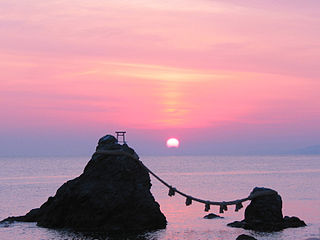
Mie Prefecture is a prefecture of Japan located in the Kansai region of Honshu. Mie Prefecture has a population of 1,781,948 and has a geographic area of 5,774 square kilometers (2,229 sq mi). Mie Prefecture is bordered by Gifu Prefecture to the north, Shiga Prefecture and Kyoto Prefecture to the northwest, Nara Prefecture to the west, Wakayama Prefecture to the southwest, and Aichi Prefecture to the east.
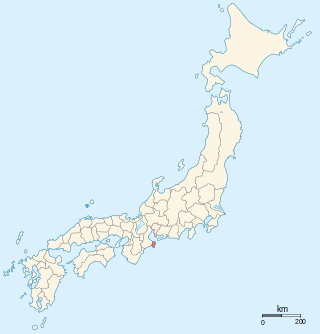
Shima Province was a province of Japan which consisted of a peninsula in the southeastern part of modern Mie Prefecture. Its abbreviated name was Shishū (志州). Shima bordered on Ise Province to the west, and on Ise Bay on the north, east and south. It roughly coincides with the modern municipalities of Shima and Toba.

Ise Province was a province of Japan in the area of Japan that is today includes most of modern Mie Prefecture. Ise bordered on Iga, Kii, Mino, Ōmi, Owari, Shima, and Yamato Provinces. Its abbreviated form name was Seishū (勢州).

The Nagoya Line is a railway line owned and operated by the Kintetsu Railway, a Japanese private railway company, connecting Nagoya and Ise Nakagawa Station in Matsusaka, Mie Prefecture via Kuwana, Yokkaichi, Suzuka, Tsu municipalities along the Ise Bay. The official starting-point of the line is Ise-Nakagawa and the terminus is Nagoya; however, operationally trains run "down" from and "up" towards Nagoya.

The Ise Shrine, located in Ise, Mie Prefecture of Japan, is a Shinto shrine dedicated to the solar goddess Amaterasu. Also known simply as Jingū (神宮), Ise Shrine is a shrine complex composed of many Shinto shrines centered on two main shrines, [Naikū] Error: {{nihongo}}: transliteration text not Latin script (help) (内宮) and [Gekū] Error: {{nihongo}}: transliteration text not Latin script (help) (外宮).

Meoto Iwa (夫婦岩), or Married Couple Rocks, are a kind of rock formation seen as religiously significant in Shinto. They are a subtype of Iwakura rock.

The Yamada Line is a railway line of the Japanese private railway company Kintetsu Railway, connecting Ise-Nakagawa Station and Ujiyamada Station in Japan. The line runs parallel to parts of the JR Central Kisei Main Line and Sangū Line.

Ujiyamada Station is a junction railway station located in the city of Ise, Mie Prefecture, Japan, operated by the private operator Kintetsu. It is the closest station to Ise Grand Shrine and thus has an important role for tourists and pilgrims. The station also administrates the section between Kushida Station and Isuzugawa Station.
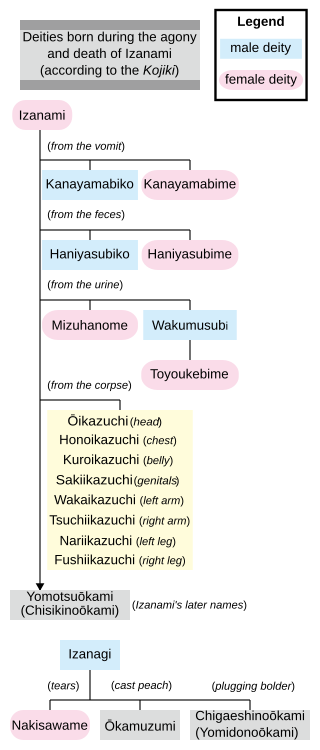
Toyouke-hime is the goddess of agriculture, industry, food, clothing, and houses in the Shinto religion. Originally enshrined in the Tanba region of Japan, she was called to reside at Gekū, Ise Shrine, about 1,500 years ago at the age of Emperor Yūryaku to offer sacred food to Amaterasu Ōmikami, the Sun Goddess.

Iseshi Station is a union passenger railway station located in the city of Ise, Mie Prefecture, Japan, operated by JR Central and the private railway operator Kintetsu Railway.
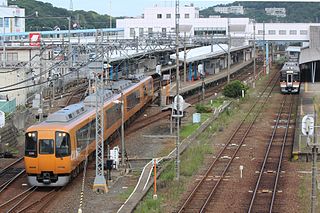
The Toba Line is a railway line operated by the Japanese private railway company Kintetsu Railway, connecting Ujiyamada Station in Ise, Mie with Toba Station in Toba, Mie. The line runs parallel to JR Central's Sangū Line.
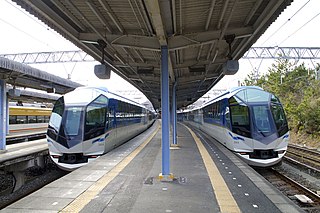
The Shima Line is a railway line in Mie Prefecture, Japan, operated by private railway operator Kintetsu Railway, connecting Toba Station in Toba with Kashikojima Station in Shima.

The Sangū Line is a railway line run by Central Japan Railway Company, connecting Taki Station with Toba Station in Japan.

Ise Electric Railway, usually abbreviated as Iseden (伊勢電), was a private railway company that operated mostly in Mie Prefecture, Japan, for 25 years from 1911 to 1936, when it was absorbed by Sangū Express Electric Railway. At its height, Iseden operated three train lines, two of which it planned and built, that serviced the cities of Yokkaichi, Tsu, Suzuka, Matsusaka, Ujiyamada, and Ōgaki. Much of the infrastructure of Iseden is now owned by Kintetsu and remains in use today.

The Miya River is a major river that flows through central Mie Prefecture on the island of Honshū, Japan. It is officially classified as a Class 1 river by the Japanese government and is one of four Class 1 rivers that flow solely through Mie; it is the longest among these four.

The Mie (みえ) is a Rapid train service in Japan operated by Central Japan Railway Company, which runs from Nagoya to Iseshi and Toba. The service passes through several significant locations en route, such as Tsu, the capital city of Mie Prefecture.

The Toyomiyazaki Bunkō (豊宮崎文庫) was a library and academy in the Edo period located in the Okamoto neighborhood of the city of Ise, Mie, Japan. It was an important resource for kokugaku scholars in the Bakumatsu period. Along with the Kanazawa Bunko and Ashikaga Bunko, it was one of the largest and most important collections in pre-modern Japan. The building once housing the collection was designated a National Historic Site of Japan in 1923.
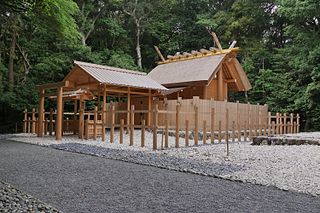
Izawa-no-miya (伊雑宮) is a Shinto shrine in the Kaminogō neighborhood of Isobe in the city of Shima in Mie Prefecture, Japan. It is one of the two shrines claiming the title of ichinomiya of former Shima Province. Together with the Takihara-no-miya (瀧原宮) in Taiki, it is one of the Amaterasu-Ōkami no Tonomiya (天照大神の遙宮), or external branches of the Inner Shrine of the Ise Grand Shrine.

Izawa Jinja (伊射波神社) is a Shinto shrine in the Arashima neighborhood of the city of Toba in Mie Prefecture, Japan. It is one of the two shrines claiming the title of ichinomiya of former Shima Province. The main festivals of the shrine are held annually on January 9, June 7 and November 23. It is also referred to as the Shima Daimyōjin (志摩大明神).

Futami-ga-ura is a sub-bay or inlet of Ise Bay in Japan, where the Isuzu River enters the bay.

































